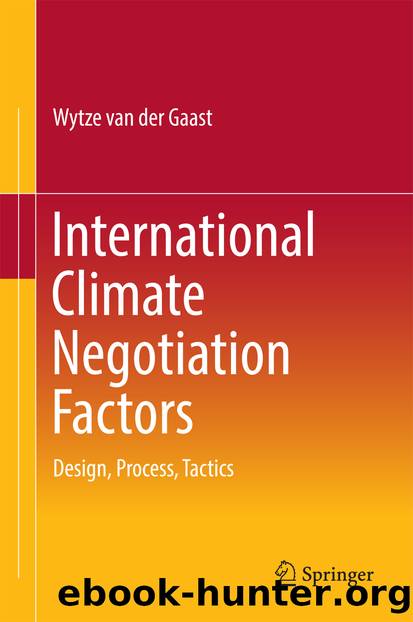International Climate Negotiation Factors by Wytze Gaast

Author:Wytze Gaast
Language: eng
Format: epub
Publisher: Springer International Publishing, Cham
4.3 Concluding Negotiations on the Berlin MandateâThe Kyoto Climate Conference
At COP-3 (Kyoto, Japan, December 1997), negotiations continued based on a list of articles which had been suggested by Parties during the AGBM process for a legal instrument or protocol10 and several text proposals for each article. The main focus was on the proposed Article 3 of the protocol which was about commitments for countries and which had been so heavily discussed during the AGBM process (especially whether and how to differentiate these commitments, and what flexibility to offer developed countries in terms of accounting for greenhouse gas emission reduction, location and timing).
The debate on commitments took place in the context of Estradaâs11 âbig bubbleâ proposal (IISD 1997b, p. 7). In this proposal, the EU was to reduce its emissions by 8 % below 1990 levels during a proposed commitment period of 2006â2010 (note that before AGBM-6, the EU had proposed to collectively reduce its emissions by 15 %). Estrada proposed a â5 % target for Canada, the Russian Federation, the USA, and Ukraine, and â4.5 % for Japan. Countries like Australia and Norway had to limit their greenhouse gas emissions to 5 % above 1990 levels. Together, developed countries would reduce their emissions by 5 % below 1990 emission levels. The differences in targets in Estradaâs proposal were a reflection of different national circumstances of the Parties (e.g., large reliance on renewables, or strong coal sector), although no formal calculation method for differentiation, as proposed at a number of AGBM sessions, had been used for this. The proposed targets in the âbig bubbleâ could be achieved by reducing emissions of three greenhouse gases (CO2, CH4, and N2O).
Informal discussions persuaded the Chair to make several adjustments to his proposal, especially with respect to flexibility, the number of gases covered, delaying the commitment period (the period during which countries would be held accountable for their achieved greenhouse gas emission reductions or limitations) to 2008â2012, and voluntary commitments for developing countries. On the last day of the COP, when negotiations continued âround the clockâ, the Russian Federation and Ukraine expressed their dissatisfaction with the differentiated targets because they did not reflect both countriesâ proposals to stabilise their greenhouse gas emissions at 1990 levels (when they were still part of the Soviet Union, and thus before the disintegration of the communist system). Eventually, Article 3 was adopted with quantified emission reduction or limitation commitments for developed countries (QELRCs; note that the word objectives was replaced by the legally stronger term commitments), which were listed in Annex B to the Protocol (UNFCCC 1998a).
On aggregate, developed countries agreed to reduce their greenhouse gas emissions (for six gases, listed in Annex A of the Kyoto Protocol) by 5.2 % during the period 2008â2012 (the so-called first commitment period) compared to 1990 emission levels. These commitments were defined as national emission budgets (so-called assigned amounts), which were expressed as a percentage of developed countriesâ emissions levels in 1990. For example, a country with an assigned amount of 93 % must reduce its emissions by 7 %.
Download
This site does not store any files on its server. We only index and link to content provided by other sites. Please contact the content providers to delete copyright contents if any and email us, we'll remove relevant links or contents immediately.
| Automotive | Engineering |
| Transportation |
Whiskies Galore by Ian Buxton(41872)
Introduction to Aircraft Design (Cambridge Aerospace Series) by John P. Fielding(33064)
Small Unmanned Fixed-wing Aircraft Design by Andrew J. Keane Andras Sobester James P. Scanlan & András Sóbester & James P. Scanlan(32743)
Craft Beer for the Homebrewer by Michael Agnew(18140)
Turbulence by E. J. Noyes(7935)
The Complete Stick Figure Physics Tutorials by Allen Sarah(7307)
Kaplan MCAT General Chemistry Review by Kaplan(6866)
The Thirst by Nesbo Jo(6826)
Bad Blood by John Carreyrou(6544)
Modelling of Convective Heat and Mass Transfer in Rotating Flows by Igor V. Shevchuk(6391)
Learning SQL by Alan Beaulieu(6209)
Weapons of Math Destruction by Cathy O'Neil(6142)
Man-made Catastrophes and Risk Information Concealment by Dmitry Chernov & Didier Sornette(5921)
Digital Minimalism by Cal Newport;(5661)
Life 3.0: Being Human in the Age of Artificial Intelligence by Tegmark Max(5474)
iGen by Jean M. Twenge(5366)
Secrets of Antigravity Propulsion: Tesla, UFOs, and Classified Aerospace Technology by Ph.D. Paul A. Laviolette(5309)
Design of Trajectory Optimization Approach for Space Maneuver Vehicle Skip Entry Problems by Runqi Chai & Al Savvaris & Antonios Tsourdos & Senchun Chai(5011)
Pale Blue Dot by Carl Sagan(4908)
